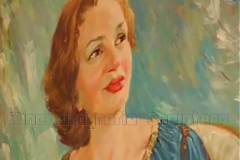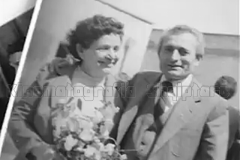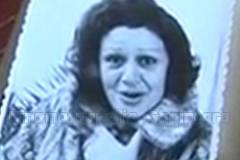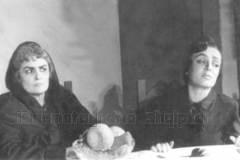Drita Agolli (1925-2017)
Theater director, actress, acting teacher.
She was born on June 2, 1925 in Maqellare Peshkopi. Agolli attended the “Nena Mbretereshe” gymnasium for three years, where she then spent the last year illegally participating in the National Anti-Fascist War – Liberation.
In 1950, she entered the “Teatri Popullor”. Her first role is that of Mariel in the drama “Voice of America” by B. Llavrenjev, starting 1 year later in 1951. In the period 1954 – 1956, she attended higher studies at the Institute of Fine Arts in Bucharest in Romania for scenography and theater costume design. Until 1960, she continued her university studies in directing at the State Institute of Theatrical Art GITIS, in Moscow BS, thus being the first female director to graduate.
She worked for several years as an actress and director in the “Teatri Popullor”! Agolli gives the greatest help as a teacher of acting skills and head of the department of drama at the High Institute of Arts, preparing many outstanding artists on stage and on screen.
As an actress, she has performed several roles in the National Theatre: Gertrude in “The Tragedy of Hamlet” by Shakespeare (1961); Clea in Figueredo’s “The Fox and the Grapes” (1961); Ortensia in Carlo Goldoni’s “Lady of the Inn” (1962); has also performed leading roles in the plays “Otello” as Blanka; “Over the letters” like Drita; “The gardener’s dog” in the role of Anarde; “Carnivals of Korce” such as Dona Lucia, etc.
Drita Agolli was a director with an inclination and taste for the poetic-dramatic conception of the stage work. With the dramatization of the novel “Dead River” by Jakov Xoxa from Kudret Velca in 1975, it manages to create an epic performance, where the dimensions of the popular, massive spectacle are felt, with epic and tragic tones. The breath and breadth of the representation of different social layers, the internal rhythm, the perceptual drawing of the expressive details in the living environments, the typical costume design, the penetrating gestures and eyes of the actresses in the volley of the artistic figures, also the paradigmatic character of the detail turned into a directorial find ( the carriage, the house, fate and the curse of Pirro Shpiragu) were the features criticized by the critics in the director Drita Agolli. Such features appear as a style in other shows as well.
One of the significant achievements of the director was the drama “Intrigue and love” by Shiler (1979) with the subtitle Luiza Miller, devoting a special importance to those parts that helped to reveal the inner world of the characters, according to a concept of directorial approach that connected the historical circumstances, the environments as well as the social and moral conflicts presented by Schiller’s well-known dramatic work on a level of contemporaneity with political emphasis.
In 1980, she gives another dimension to S. Pitarka’s play “Fisherman’s Family” staged by “Skampa” Elbasan theater. Here she clearly insists on the inner pathos and the heroic spirit that the work carries, tempered, of course, by her own artistic preferences.
Thoughts and figures in some performances of Drita Agolli are developed in the form of a leitmotif, such as visions and sounds mainly poetic, often metaphorical, with synthetic details, such as in “Marjana Pineda” by Lorca at the Theater of Berat in 1989, or a report contrapuntal, where spiritual fragility, reason and love are disturbed and violated by instinct, rudeness and the feeling of humiliation, such as in M. Jero’s “Bridge” in 1972 at the Theater of the High Institute of Arts and later in “Man, virtue and the animal” by Pirandello at the National Theater (2000);
Ms. Agolli has also staged the opera “Vjosa” at the Opera and Ballet Theater where the strong dramatic treatment of the choir’s mass stood out. Drita Agolli has also contributed to the theoretical and critical thinking about Albanian theater in several articles.
She wrote the book “The unnamed” (1997). Only in 2001, after a long time, she was given the title “Great Master of Work”.
Since 1985, she holds the honorable title “Merited Artist”
Other shows as a director: 1963 – Shterngata | 1965 – Lampa e neonit |
1967 – Toke e zjarrte | 1978 – Pabesia | 1981 – Njerez te thellesive
1984 – Djali plangeprishes | 1988 – Shenomeni edhe mua
Published on the Facebook page in June 2016 and revised in subsequent years.
__________________
Albanian Cinematography in activity since 2013
Reference: Encyclopedia – Albanian Theater and Cinematography (2009) J. Papagjoni /p. 8-9 / 60 years National Theater (1945 -2005) F. Slatina / p. 58.
Follow us: Blog: https://albaniancinematography.blogspot.com/ Vimeo: Albanian Cinematography (vimeo.com) Facebook: https://www.facebook.com/ksh.faqjazyrtare Dailymotion: https://www.dailymotion.com/kinetografiashqiptareartisporti YouTube: https://www.youtube.com/channel/UCDRYQ5xCyGkfELm3mX8Rhtw
Discover more from Albanian Cinematography - Sport
Subscribe to get the latest posts sent to your email.

































